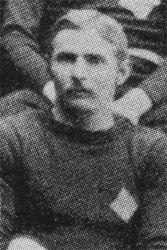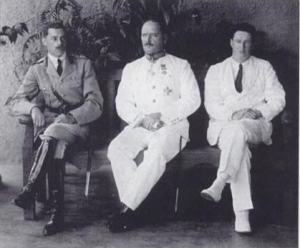Related Research Articles

Andrew Geddes Bain, was a South African geologist, road engineer, palaeontologist and explorer.

Fielding Harris Yost was an American college football player, coach and athletics administrator. He served as the head football coach at: Ohio Wesleyan University, the University of Nebraska, the University of Kansas, Stanford University, San Jose State University, and the University of Michigan, compiling a coaching career record of 198–35–12. During his 25 seasons as the head football coach at Ann Arbor, Yost's Michigan Wolverines won six national championships, captured ten Big Ten Conference titles, and amassed a record of 165–29–10.

St. Andrew's College is an Anglican high school for boys located in Makhanda (Grahamstown), Eastern Cape province of South Africa. It was founded in 1855 by the Right Reverend John Armstrong, the first Bishop of Grahamstown. It is a semi boarding school, with a number of day boys. St. Andrew's College caters to 480 pupils from around the globe. The school is also a member of the G30 Schools group and closely associated with its brother school, St. Andrew's Preparatory School, and its sister school the Diocesan School for Girls.
Henry Melville Taberer was a South African cricketer who played in one Test match in 1902. He was the son of the Revd C. Taberer and was born at a mission station in Keiskammahoek, Cape Province.

The Albany Museum, South Africa is situated in Grahamstown in South Africa, is affiliated to Rhodes University and dates back to 1855, making it the second oldest museum in South Africa.
Reginald Cuthbert Mullins was a South African rugby union forward and medical doctor. Mullins played club rugby for Oxford University and played international rugby for the British Isles XV in their 1896 tour of South Africa.

Harry Churchill Boyes was a South African international rugby union winger.

Walter Stringfellow Taberer was a South African international rugby union player. Born in King William's Town, he attended St. Andrew's College, Grahamstown, where he was a Douglass Scholar before playing provincial rugby for Griqualand West. He made his only Test appearance for South Africa during Great Britain's 1896 tour. He played as a centre in the 2nd Test of the series, a 17–8 South Africa loss. Taberer died in 1938, in Bulawayo, at the age of 65.
Henry Francis Fynn was an English traveler and trader. He was among the first Europeans to make contact with Shaka Zulu. Fynn, Coenraad De Buys, John Dunn and Nathaniel Isaacs were among the most famous of South Africa's so-called White Chiefs.

Sir Robert Thorne Coryndon, was a British colonial administrator, a former secretary of Cecil Rhodes who became Governor of the colonies of Uganda (1918–1922) and Kenya (1922–1925). He was one of the most powerful of colonial administrators of his day.

Sir George Edward Cory, was an English-born South African chemist and historian, best known for his six-volume publication "The Rise of South Africa".
Frederick York St Leger was the Irish founder of the Cape Times newspaper in South Africa, and an Anglican priest.

Guybon Damant Atherstone M. Inst. C.E. AKC, South African railway engineer.
Ivan Mitford-Barberton (1896–1976) was a sculptor, writer and authority on heraldry.
Herbert Melville Guest was an author, newspaper owner and politician of the Transvaal. He acquired the Klerksdorp Mining Record in 1889. He wrote several books on the Second Boer War in the area of Klerksdorp. In 1903 he became one of the first city council members and was mayor from 1910 to 1911. One of his sons was Ernest Lucas Guest, the prominent government minister of Southern Rhodesia.
Arthur Matthews was a founding professor at Rhodes University in Grahamstown, South Africa.
Athelstan Hall Cornish-Bowden was a land surveyor active in South Africa in the 19th and 20th centuries.
Vere Palgrave Stent (1872-1941) Journalist and war correspondent, theatre critic, playwright and author
Claude Albemarle Bettington was a mining engineer and a pioneer aviator from South Africa.
Benjamin John Peter Tyamzashe was a South African Xhosa music composer, teacher, principal, choir conductor and organist.
References
- ↑ Laurie 1914, p. 108.
- ↑ Seary 1947, p. 20.
- ↑ Ernest Glanville
- Laurie, K. W. J. (1914). Register of S. Andrew's College, Grahamstown, from 1855 to 1914. Grahamstown: Slater & Co.
- Marquard, Jean; Trump, Martin, eds. (1993). A Century of South African Short Stories. Ad. Donker. ISBN 978-0-86852-194-7.
- Seary, E. R., ed. (1947). South African Short Stories. Oxford University Press.